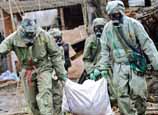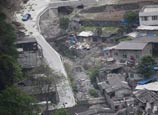
BEIJING, April 25 (Xinhua) -- Southwestern Sichuan Province is making every effort to carry out rescue and relief work in the quake-hit region, and prepare for the post-quake reconstruction, local authorities said at a press conference here Thursday.
Search and rescue work is still under way though the "golden rescue time," or the first 72 hours after the quake, is over, said Zhong Mian, vice governor of the province.
As of 6 p.m. Wednesday, the devastating earthquake, which struck Lushan County in Ya'an City Saturday morning, has left 196 dead, 21 missing and 13,484 injured, according to Zhong, adding that rescuers have saved over 470 people from the debris.
The Sichuan provincial government has cooperated with relevant departments of China's central government actively to help resettle the affected residents in the earthquake, Zhong said.
About 295,000 people in the quake-stricken region have been relocated so far. A total of 69,000 tents, 217,000 quilts and about 2,351 tonnes of drinking water have been sent to the region, Zhong added.
In a response to a question concerning alleged discrimination during the process of relief goods distribution, Zhong said goods and funds will be sent to people affected in the deadly quake, regardless of their nationalities or their "hukou" -- Chinese household registration records.
Some netizens living in the quake-hit region complained in their micro-blogging posts that they had not received enough tents and food.
Zhong explained that quake-relief materials were on the way to remote and seriously-hit areas, but roads leading to these areas were disrupted by falling boulders as a result of frequent aftershocks.
"The relief goods were distributed mainly at some concentrated resettlement sites set up by local governments," Zhong added. "It may take some time for the goods to be transported to some remote and scattered relocation sites."
However, helicopters were dispatched to airlift relief goods to those areas while soldiers and rescue troops trekked to isolated regions, carrying relief necessities such as tents, bottled water and food over the first three days after the quake, Zhong said.
Pang Chenmin, a spokesman for the Ministry of Civil Affairs (MCA), said at the press conference that the condition of tents and problems with food shortages in the quake-hit region have improved as of Wednesday.
With regard to the water supply, Zhong said water in the region was not polluted according to environmental and experts' investigations.
"We will send personnel to speed up the repair work of the damaged reservoirs and water supply systems so that the drinking water in the region can resume soon," Zhong said.
Zhong also revealed that a total of 186,300 rural buildings collapsed in the quake and about 430,000 homes were gravely damaged.
Some media questioned why so many buildings collapsed or were damaged as they were built to a high-required standard in the wake of the Wenchuan earthquake, which occurred also in Sichuan in May 2008, leaving 87,000 dead or missing.
Qiu Jian, the chief planner of the housing and urban-rural development department of Sichuan Province, explained that the department had dispatched 400 experts to make assessments on the conditions of the affected houses in the quake region.
"The collapsed buildings were mainly built by the villagers themselves. As for the buildings constructed as part of post-quake programs following the Wenchuan earthquake, none of them collapsed though these buildings bore some cracks or broken walls," Qiu said.
The major structure of the buildings were not damaged so we can say that those built after the Wenchuan quake, especially school and hospital buildings, are up to the anti-quake standard, according to Qiu.
The chief planner told Xinhua it is hard to say whether they will build a new county seat for Lushan County, the epicenter of the earthquake, at present as the rescue and relief work is still ongoing and further disaster assessments are needed.
Zhong said the provincial government had urged quake-stricken areas to get back to a normal routine, including resuming classes, businesses as well as bank services.
Zhong also pointed out that the government faces difficulties regarding the prevention of secondary disasters triggered by the Lushan earthquake and its aftershocks because experts have found over 1,900 potential geo-hazard points and the region is approaching the flood season.
The government will carry out a series of measures to prevent further disasters and make full preparation for the post-quake reconstruction, according to Zhong.
Latest development of H7N9 in China[Special]
















 Giant pandas safe in quake-hit zone
Giant pandas safe in quake-hit zone


![]()
